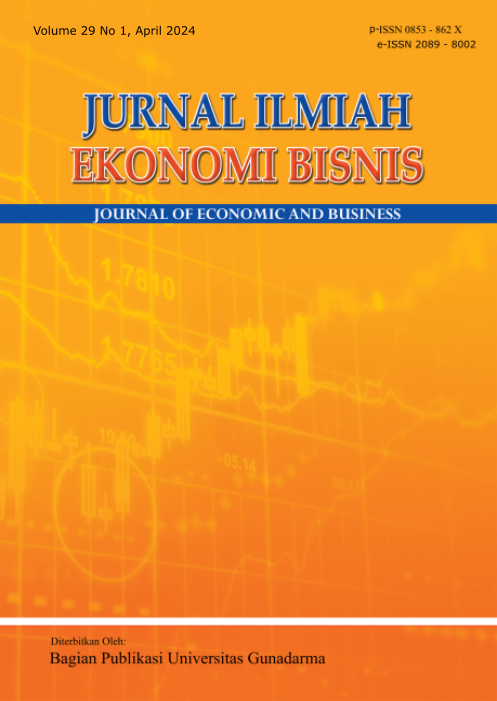COMPETITIVE ADVANTAGE ANALYSIS: A VALUE CHAIN MODEL IN THE JEMBER CARNIVAL INDUSTRY
University of Jember
Indonesia
University of Jember
Indonesia
University of Jember
Indonesia
University of Jember
Indonesia
University of Jember
Indonesia
Abstract
The subsector of performing arts studied in this research is in carnival performance art. The pandemic era has made the performance of all business entities decline, including in the creative industry of the performing arts subsector (Carnival). The research method used is qualitative research, namely by describing and exploring the application of value chains and culture in the creative industry of the carnival performing arts subsector in the Jember region. The data were collected through interviews, observations, and document analysis. The study concludes with the identification of the value chain sustainability model event in Jember, comprising five key elements. These elements include creation, production, dissemination, exhibition, and consumption, indicating the presence of a comprehensive value chain within the Jember Regency carnival event. Jember Carnival's one-of-a-kind creative vision woven through the entire elements, from creation to consumption, gives it a major differentiation advantage compared to standardized carnival offerings. The uniqueness provides lasting value and competitive edge. A potential chain that can be used as a source of competitive advantage for the sustainability of the Jember carnival event is to have a different creation from other carnivals.
Keywords
References
Abdila, R. (2019). Bekraf: Subsektor seni pertunjukan terus alami pertumbuhan - Tribunnews.com. Retrieved from: https://www.tribunnews.com/bisnis/2019/10/14/bekraf-subsektor-seni-pertunjukan-terus-alami-pertumbuhan.
Chen, X., Liu, C., Jiang, Y., & Gao, C. (2021). What causes the virtual agglomeration of creative industries? Sustainability (Switzerland), 13(16), 1–18. doi.org:10.3390/su13169232
Cunningham, S. (2011). Research article developments in measuring the “creative” workforce. Cultural Trends, 20(1), 25–40. doi.org:10.1080/09548963.2011.540810.
Cunningham, S. (2015). You’re hot, then you’re cold: Creative industries policy making in Australia. Creative Business in Australia, 159–171. Retrieved from: http://epress.lib.uts.edu.au/system/files_force/CreativeBusinessinAustralia_2.pdf?download=1
Eikhof, D. R., & Haunschild, A. (2007). For art’s sake! Artistic and economic logics in creative production. Journal of Organizational Behavior, 28(5), 523–538. doi.org:10.1002/job.462
Kaminski, A.M. , Genschik, S., Kefi, A.S., & Kruijssen, F. (2018). Commercialization and upgrading in the aquaculture value chain in Zambia. Aquaculture, 493(1 August 2018), 355-364. doi.org:10.1016/j.aquaculture.2017.12.010.
Kotler, P. & Keller, K. L. (2009). Manajemen pemasaran (13th ed.). Jakarta: Erlangga.
Madudová, E. (2017). Creative industries value chain: The value chain logic in supply chain relationships. Marketing and Branding Research, 4(3), 227–235. doi.org:10.33844/mbr.2017.60236.
Mentzer, J. T., Min, S., & Zacharia, Z. G. (2000). The nature of interfirm partnering in supply chain management. Journal of Retailing, 76(4), 549–568. doi.org:10.1016/S0022-4359(00)00040-3.
Nastiti, P., & Setyohadi, D. B. (2020). Identification of critical factors on structure and conduct using SCP framework: Evidence from Indonesian ICT industry. JCSSE 2020 - 17th International Joint Conference on Computer Science and Software Engineering, 24–29. doi.org:10.1109/JCSSE49651.2020.9268252.
Pearce, J. A., & Robinson, R. B. (2013). Strategic management : planning for domestic & global competition (13th ed.). New York: McGraw-Hill/Irwin.
Perwita, F., & Sudjatno. (2015). Identifikasi kompetensi inti dan analisis rantai nilai untuk meningkatkan keunggulan bersaing pada usaha olahan apel KSU Brosem di Kota Batu. Jurnal Ilmiah Mahasiswa FEB, 3(2), 1–8. Retrieved from: https://jimfeb.ub.ac.id/index.php/jimfeb/article/view/2288
Porter, M. (1985). Competitive advantage, creating and sustaining superior performance. Revista de Administração de Empresas, 25(2), 82–84. doi.org:10.1590/s0034-75901985000200009.
Shakouhi, F., Tavakkoli-Moghaddam, R., Baboli, A., & Bozorgi-Amiri, A. (2022). Multi-objective programming and Six Sigma approaches for a competitive pharmaceutical supply chain with the value chain and product lifecycle. Environmental Science and Pollution Research, 29(26), 1–21. doi.org:10.1007/s11356-022-21302-x.
Skippari, M., Laukkanen, M., & Salo, J. (2017). Cognitive barriers to collaborative innovation generation in supply chain relationships. Industrial Marketing Management, 62(April 2017), 108–117. doi.org:10.1016/j.indmarman.2016.08.002.
Stipanović, C., Rudan, E., & Zubović, V. (2019). Cultural and creative industries in urban tourism innovation – the example city of Rijeka. Tourism in Southern and Eastern Europe, 5, 655–666. doi.org:10.20867/tosee.05.47.
Subagyo, I. E., Saraswati, D. S., & Trilaksono, T. (2019). Industrial value chain in Indonesia's SME creative business : An exploration research. Journal of Management and Business, 18(1), 54–71. doi.org:10.24123/jmb.v18i1.410.
Sugiyono, P. D. (2019). Metode penelitian kuantitatif, kualitatif, dan R&D (19th ed.). Bandung: Alfabeta, CV.


